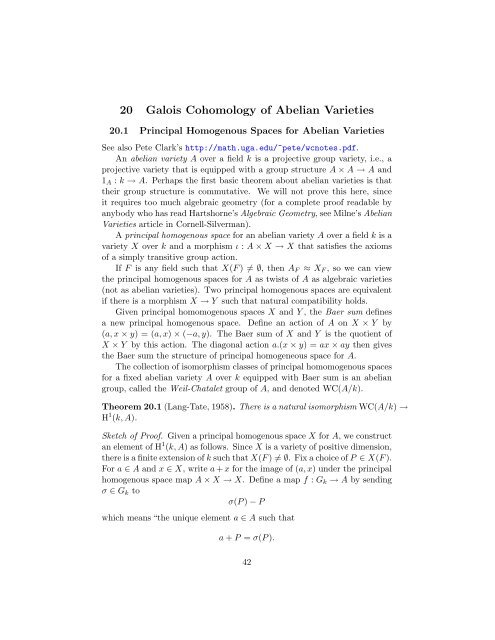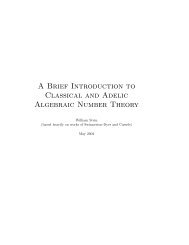A Short Course on Galois Cohomology - William Stein - University of ...
A Short Course on Galois Cohomology - William Stein - University of ...
A Short Course on Galois Cohomology - William Stein - University of ...
You also want an ePaper? Increase the reach of your titles
YUMPU automatically turns print PDFs into web optimized ePapers that Google loves.
20 <strong>Galois</strong> <strong>Cohomology</strong> <strong>of</strong> Abelian Varieties<br />
20.1 Principal Homogenous Spaces for Abelian Varieties<br />
See also Pete Clark’s http://math.uga.edu/~pete/wcnotes.pdf.<br />
An abelian variety A over a field k is a projective group variety, i.e., a<br />
projective variety that is equipped with a group structure A × A → A and<br />
1A : k → A. Perhaps the first basic theorem about abelian varieties is that<br />
their group structure is commutative. We will not prove this here, since<br />
it requires too much algebraic geometry (for a complete pro<strong>of</strong> readable by<br />
anybody who has read Hartshorne’s Algebraic Geometry, see Milne’s Abelian<br />
Varieties article in Cornell-Silverman).<br />
A principal homogenous space for an abelian variety A over a field k is a<br />
variety X over k and a morphism ι : A × X → X that satisfies the axioms<br />
<strong>of</strong> a simply transitive group acti<strong>on</strong>.<br />
If F is any field such that X(F ) = ∅, then AF ≈ XF , so we can view<br />
the principal homogenous spaces for A as twists <strong>of</strong> A as algebraic varieties<br />
(not as abelian varieties). Two principal homogenous spaces are equivalent<br />
if there is a morphism X → Y such that natural compatibility holds.<br />
Given principal homomogenous spaces X and Y , the Baer sum defines<br />
a new principal homogenous space. Define an acti<strong>on</strong> <strong>of</strong> A <strong>on</strong> X × Y by<br />
(a, x × y) = (a, x) × (−a, y). The Baer sum <strong>of</strong> X and Y is the quotient <strong>of</strong><br />
X × Y by this acti<strong>on</strong>. The diag<strong>on</strong>al acti<strong>on</strong> a.(x × y) = ax × ay then gives<br />
the Baer sum the structure <strong>of</strong> principal homogeneous space for A.<br />
The collecti<strong>on</strong> <strong>of</strong> isomorphism classes <strong>of</strong> principal homomogenous spaces<br />
for a fixed abelian variety A over k equipped with Baer sum is an abelian<br />
group, called the Weil-Chatalet group <strong>of</strong> A, and denoted WC(A/k).<br />
Theorem 20.1 (Lang-Tate, 1958). There is a natural isomorphism WC(A/k) →<br />
H 1 (k, A).<br />
Sketch <strong>of</strong> Pro<strong>of</strong>. Given a principal homogenous space X for A, we c<strong>on</strong>struct<br />
an element <strong>of</strong> H 1 (k, A) as follows. Since X is a variety <strong>of</strong> positive dimensi<strong>on</strong>,<br />
there is a finite extensi<strong>on</strong> <strong>of</strong> k such that X(F ) = ∅. Fix a choice <strong>of</strong> P ∈ X(F ).<br />
For a ∈ A and x ∈ X, write a + x for the image <strong>of</strong> (a, x) under the principal<br />
homogenous space map A × X → X. Define a map f : Gk → A by sending<br />
σ ∈ Gk to<br />
σ(P ) − P<br />
which means “the unique element a ∈ A such that<br />
a + P = σ(P ).<br />
42
















